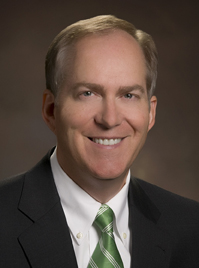October 9, 2014
How Greenville Got its Groove Back
by Mary Carr Mayle, Savannah Morning News

It’s a familiar story. A growing city sprawling out into the suburbs, its main downtown retail district left with empty buildings and little foot traffic as modern shopping malls crop up on the edges of town.
Greenville’s story wasn’t much different from other cities its size. But what Greenville did about it has turned the thriving city in South Carolina’s Piedmont region into a true success story that’s been touted by everyone from Forbes to Travel & Leisure to the National Trust for Historic Preservation.
Speaking Wednesday morning at HunterMaclean’s 2014 Critical Issues Forum, Greenville Mayor Knox White detailed his city’s downtown renaissance for area leaders gathered in the Eckburg Auditorium at Savannah Technical College.
When he took office in 1995, White said, his intention was to make Greenville “the most beautiful and livable city in America.”
Acknowledging that description might meet some resistance with a Savannah audience, White went on to make his case for Greenville as the best downtown revitalization in America.
Over the past several decades, White said, Greenville has reinvented itself from an economy dependent on textile manufacturing to a diversified and advanced manufacturing hub featuring such industries as BMW, Fluor Corp., Michelin and GE.
Its once-deserted downtown is flourishing, with a mix of retail and restaurants, offices, residential and green space creating a vibrant 24/7 atmosphere.
“One of the most interesting phenomena taking place in cities these days is the return of two particularly desirable groups – young people and retirees,” White said. “It presents America’s cities with both great opportunity and challenges to create the kind of urban environment that’s attractive, safe, walkable and has the kinds of amenities these groups want.
So many cities in America are starting to get with the program to do that.”
Greenville was ahead of the curve, creating not only a business friendly environment that would attract investment and development but a downtown area that’s a livable magnet for a wide range of groups.
Asked how that was accomplished, White said the word that keeps popping into his head is intentional.
“For so many decades, we have worked steadily and intentionally to plan well and to create great partnerships between the city and the business community,” he said. “Some cities start out with lots of enthusiasm and then leadership changes or something else slows the plan down and it’s lost. We’ve been fortunate in that we really haven’t lost our focus, and it’s helped us do some pretty substantial things.”
It also helps that Greenville is blessed with a strong, diversified local economy, he said.
White’s predecessors started the ball rolling in the 1970s by taking advantage of a nearly deserted downtown to develop a streetscape plan for Main Street.
“They narrowed the wide, four-lane street to two lanes and installed parks, plazas and decorative light fixtures,” he said. “They also planted trees – small trees that have now grown into a wonderful canopy for miles along Main Street.”
With that new streetscape in place, downtown was ready for private investment. That came in the 1980s in the form of the Greenville Commons/Hyatt Regency Project, a luxury convention hotel on Main Street.
It would prove to be the first of many successful public/private partnerships.
During White’s nearly 20-year tenure, Greenville restored its historic Poinsett Hotel — now a Westin facility — and created new mixed use buildings utilizing retail, residential and office space.
Through intentional commitment and public/private partnerships, the city continued to create strong anchors throughout the downtown area. A dying industrial area was transformed into a performing arts complex that incorporated historically significant buildings with new architecture and landscaping.
A 15,000-seat arena brought a full-scale sports and entertainment venue into the heart of the city. And Fluor Field, a mixed-use minor-league baseball stadium has spurred development around it.
Then there’s Falls Park on the Reedy, a greenspace surrounded by bike and walking paths.
“As we set out to revitalize downtown, we really focused on three things – mixed use developments, public spaces and personality. On the personality side, we looked for something that would define us and set us apart,” he said.
“We had this little river running through town. It was polluted, an eyesore and development had moved away from it. The Reedy River had a waterfall, but years ago, the state had put a four-lane highway bridge over it and a lot of people either never knew or forgot it was even there.”
Today Falls Park is the centerpiece of downtown Greenville, he said.
“We spent $13 million on the park – and, yes, people thought we were crazy. But within less than two years, we had $150 million of private investment surrounding it – condominiums, restaurants, retail,” White said. “It’s the first place we take visitors and the first thing people remember about us.”
Fielding questions about Greenville’s ballpark, which Savannah’s leadership has visited to get an idea of what a mixed-use stadium complex could look like, White had some advice.
“Remember, these teams make money and should be willing to put money on the table. In today’s economy, it’s not likely you’ll find a team willing to build a stadium, but they should at least have an equity stake in the project.”




